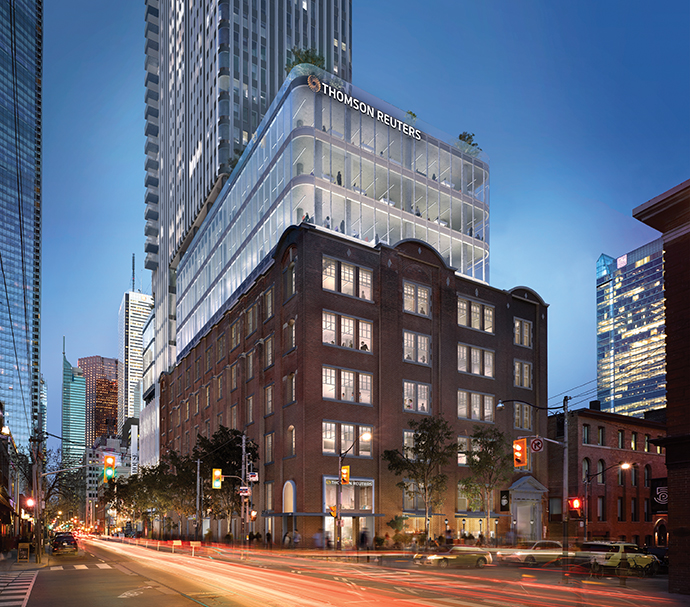When the Greater Toronto region submitted its proposal to Amazon in a bid to secure the company’s $50-billion, 50,000-job HQ2, Toronto Global leaders called their region “one of the most futureproofed locations on the planet,” thanks to a deep, growing and affordable talent base; an ongoing $154-billion infrastructure investment in Ontario; universal health care and, oh yeah, a corporate tax rate quite a bit lower than in the United States.
No wonder they didn’t offer the global giant just one candidate site. They offered 10.
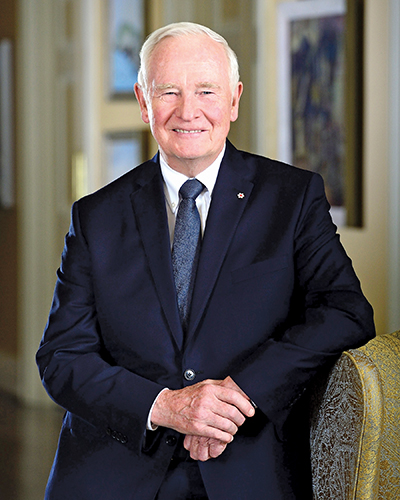
Ontario Premier Kathleen Wynne — just before she departed on her third trade mission to China, where she signed $1.9 billion in new business agreements — noted the province has the most educated workforce in the OECD (68 percent have completed a post-secondary education). And the proposal touted the province’s pledge to dramatically increase the number of post-secondary STEM students and Master’s degrees in artificial intelligence.
But the best picture they could draw was on the proposal’s cover — 4,060 pictures, in fact, depicting what’s at the root of any company’s success: people.
A 19th century idea called the “great man theory” postulated that history could largely be explained by the impact of highly influential individuals. The evidence from my 16 years of reporting around the globe and across North America shows a fair number of such people clustered in Ontario.
David Johnston, the longtime University of Waterloo leader who just finished serving as the 28th Governor-General of Canada, thinks as historians look back, this will be the first era when societies are not evaluated by GDP or armadas, but by “how well we can develop the talent of all of our people.” He says the culture of innovation requires what he calls the “five Cs”: curiosity, capability, creativity, collaboration and celebration. Ontario has all of those things in spades, he told me, beginning with the Toronto-to-Waterloo corridor.
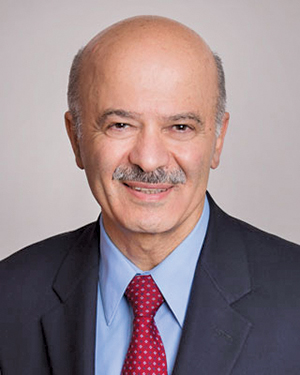
On the eastern end in Toronto, “there is more health sciences IP per square inch than anywhere else.” At the western end sits the University of Waterloo — “a very interesting ecosystem built on collaboration,” says Johnson, with a balance of academic terms and workplace experience (engineering graduates have to work at least five work terms) that he calls “a platform for lifelong learning, where theory and process go hand in hand.” The university also boasts a policy of all IP belonging to its creators. Johnston likes that. He thinks universities “should be boundless, led by curiosity, and should not be constrained by guarding secrets.”
But the secret’s out: Ontario’s is a global ecosystem like no other — in part because it welcomes the other.
Welcome Home
There are over 200 languages spoken in Toronto alone, and over 50 percent of people living in Ontario were not born there.
“We are a province that welcomes ideas and values skill, no matter where a person is from,” says Clare Barnett, vice president of investment growth at the Ontario Investment Office. “I think that is what many companies I speak to find so attractive about Ontario.”

In November came the story of Iranian AI researcher Sara Sabour, now working with globally renowned AI and machine learning pioneer Geoffrey Hinton, a professor at the University of Toronto and leader of the new Vector Institute for Artificial Intelligence, after the US denied her work visa.
“It’s the people who make things happen, not buildings or equipment or machines,” says Ontario Minister of Research, Innovation and Science Reza Moridi, an Iranian by birth himself. “I’m proud as a minister and as a former scientist. It shows how our magnets can really attract talent from all over the world. The better the talent we bring to Ontario and Canada, the better off we will be.”
New federal policy enables the immigration process to happen in two weeks rather than the two months it used to take. The Ontario Investment Office is an official referral partner to the Global Talent Stream program that facilitates business immigration into the province for key individuals, researchers and other staff within companies that are making investments in Ontario.
Easy as A-B-C
Want a smart city? The first order of business might be getting really smart companies to hang around for a while. Ontario is the hangout spot for new investors such as Slack, Samsung and Facebook, which set up shop at the MaRS Discovery District. “Our mission is to make the world more open and connected,” said Jordan Banks, head of Facebook Canada.
Sidewalk Labs, the spinoff from Google parent firm Alphabet that was chosen by Waterfront Toronto in October 2017 for a massive waterfront redevelopment investment, began with “exploring opportunities all over the world.” Now it aims to create the conditions for the creation of world-changing opportunities, based on a simple motto: “Building a city from the internet up.”
The anchor? Google’s Canadian HQ, which will relocate to where more than 800 acres (325 hectares) of the Port Lands wait to be fully developed into a mixed-use, tech-rich community, backed by a C$1.25-billion investment by federal, provincial, and municipal governments.
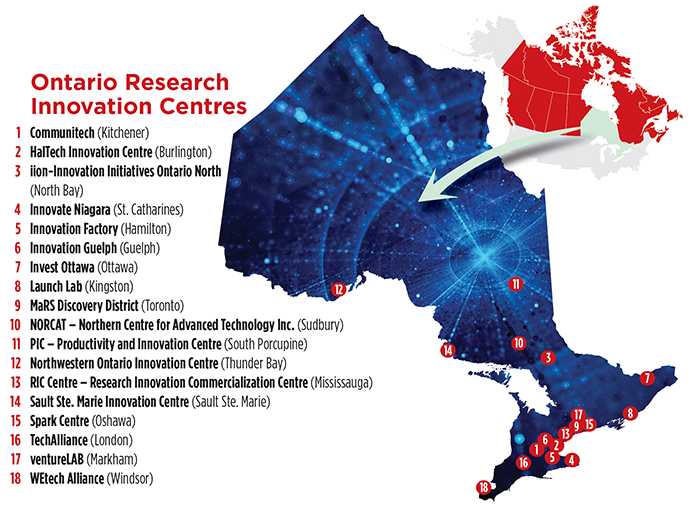
Google knows the province’s advantages from its experience growing in Kitchener-Waterloo. The Thomson part of Thomson Reuters has known them for decades, driving the global data revolution while also pioneering innovation in fintech. In 2016 Thomson Reuters, which has had a lab site at Communitech in Waterloo since 2015, announced it would create the Toronto Technology Centre downtown, beginning with 400 jobs and aiming for 1,500.
Shawn Malhotra, vice president of Thomson Reuters’ Toronto Technology Centre, is a Windsor native with a computer engineering degree from the University of Waterloo, a graduate degree from the University of Toronto and four US patents to his name. At school he knew he was surrounded by high-caliber people. Later, his employer Intel would hire interns from all over the world, but people from Waterloo and UT were always the cream of the crop. Today his experience only reinforces the fact that “the talent we have in this region is really something special,” he says.
The company’s ambitious goal of hiring 200 professionals in the areas of big data, cloud computing and machine learning within a year already had been surpassed by December, with 202 on the payroll. “For our first internship application” at the University of Waterloo, he says, “we had 250 applicants for one job.” The site “has really exceeded our expectations in terms of ability to hire and the level of talent we’re getting,” he says. “Toronto is a place seen as injecting talent into our global organization.”
Leaps and Bounds
Not that long ago the immigrants came from places like Italy, Ireland and Greece. One of their offspring was Mike Lazaridis, the co-founder of BlackBerry. Since 1999, with provincial support, he has poured hundreds of millions of dollars into co-founding Quantum Valley Investments, the Institute for Quantum Computing and the Perimeter Institute (all in Waterloo), where I recently heard him speak about, of all things, theoretical physics as a strategic investment.
The things he learned at Waterloo in the early 1980s about electrons being in two states at the same time are transforming computing, energy use and cybersecurity for the world to come. And the world’s best come there to face such conundrums as quiet labs so quiet there’s no test equipment that can measure how quiet they are. Quantum computing research lead David Cory talks about the search for dark matter in a way that makes you want to jump in and help discover it — even if you have no clue what he’s talking about.
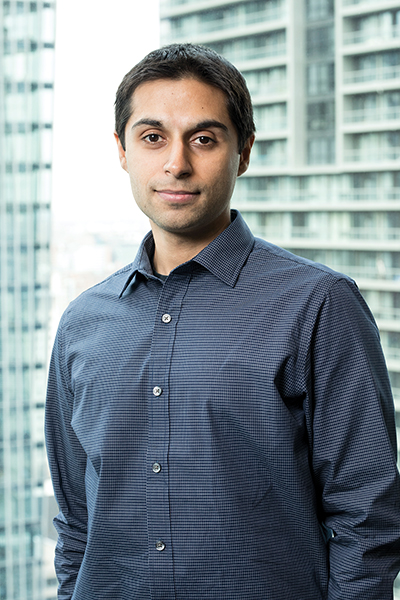
Clare Barnett has her own stories about having her mind officially blown.
“I have seen some incredible things,” she says, citing AI software from a startup called Winterlight — located in Johnson & Johnson’s JLABS incubator in Toronto — that analyzes natural speech to detect dementia. She also just watched robotic surgery technology from Ontario’s Synaptive Medical go to work on simulated brain tissue. “When you see things like that, you realize innovation is more than just advancements in components and software. People’s lives are being changed around the world because of what is happening here in Ontario.”
That includes bleeding-edge technology in traditional sectors such as automotive. Ford’s R&D commitment includes a new C$500-million investment that will mean adding about 300 more engineers in Canada and establishing a new Ottawa Research and Engineering Centre. In Markham, GM opened a Canadian Technical Centre that started with 180 employees but aims to reach a capacity of 700 in the York Region’s ICT cluster. BlackBerry just located the BlackBerry QNX Autonomous Vehicle Innovation Centre in Ottawa, not long after Ontario’s Ministry of Transportation approved BlackBerry QNX to test AVs on Ontario roads as part of a pilot program with a demonstration zone called AVIN, the Autonomous Vehicle Innovation Network, in Stratford.
Barnett says the ongoing AV work is “like being on the ground floor of the future of transportation. It’s all happening so fast, it can make your head spin — but that’s what truly gets my heart racing.”
Gabe Batstone, CEO of Internet-of-Things firm contextere, says the business ecosystem in Ottawa is vibrant with talent and lifestyle amenities, in addition to benefiting from being the nation’s capital. Among the recent high-tech investors in Ottawa are Qlik and Amazon, as well as homegrown tech star You.I Labs. Batstone lauds the efforts of Invest Ottawa and other area organizations, but notes that “success stories like Shopify do more to drive the image of a city than any strategic plan or government initiative can.”
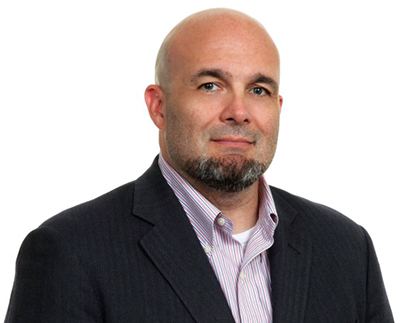
That refrain is familiar across Ontario: No need to pick winners. Just make the conditions right for winners to emerge. It’s worked for great companies like Shopify in other places too: In November it announced plans to triple its workforce in Waterloo. And it works for great individuals.
In a session I attended at the University of Toronto not long ago, Raquel Urtasun, Canada Research Chair in Machine Learning and Computer Vision at U of T (since then appointed Head of Uber ATG Toronto), neatly expressed both her own ambitions and those of the territory she calls home: “I want my algorithms to be in every single car that drives you. I am also interested in mapping the world, using apps in rescue, understanding how cities evolve and how to make cities better.”
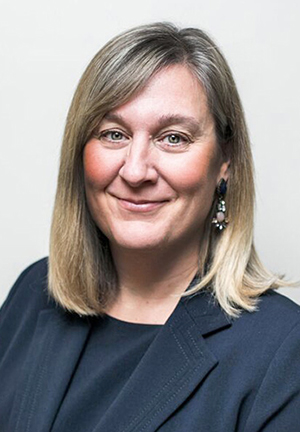
David Johnston, that former Governor-General of Canada whose name now adorns a research and technology park in Waterloo, might see that sort of ambition as the beginning of a new historical era — an era where Ontario’s great teams of great individuals are poised to show the way.
This Investment Profile was prepared under the auspices of the Ontario Investment Office, which retains and scales business in Ontario and attracts foreign investment with purpose, a bias for action, a sense of urgency and a customer-centric lens. To learn more, visit www.investinontario.com. Paid for by the Government of Ontario.
